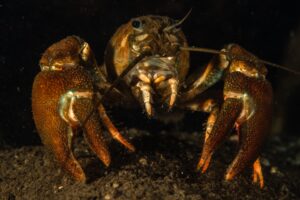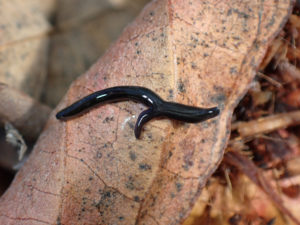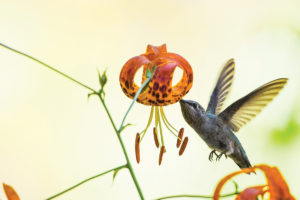We’re following what you might call a trap line through some parkland in the interior East Bay hills. It’s early in the morning and the fog is still heavy. The 12 traps we’re checking are big and boxy, homemade-looking contraptions of metal bar and wire mesh. They’re designed to catch large animals–man-size sows and even bigger boars. My guide, a trapper with a company called Rural Pig Management, would rather I not say exactly where we are, but it really doesn’t matter because the feral pigs we are trying to catch live throughout California. So we could be anywhere on open land in the Bay Area.
The history of the feral pig is a bit of an ecological folly–but one with serious consequences. These animals are walking, rooting embodiments of the curse of unforeseen consequences: They’re a mix of escaped barnyard animals and an imported game species, but they are now some of the largest and most numerous wild creatures in the Bay Area. Indeed, these animals are more than just a nuisance: They’ve become such a source of serious environmental stress that local land managers have to trap and kill pigs to keep them in check. And wild turkeys, also introduced for sport hunting, are now getting so numerous that they too might someday face similar measures.
- A wild pig rubs against a blue oak tree. Pigs and turkeys have proliferated since they were introduced—the pigs by farmers and hunters more than a century ago; the turkeys just a couple of decades ago by state wildlife officials. Pigs are especially destructive, rooting through soil and devouring the seeds and bulbs of native plants and anything else they can swallow. Photo (c)Bruce Finocchio.
To trap a wild pig you have to think like a pig, and pigs are smart. They know generally to stay away from people; they usually forage at night when they have the hills to themselves. Female pigs (sows) are prolific breeders, producing several litters of a half-dozen young or more a year, and they tend to travel in packs, called sounders, in defined areas. Dominant males (boars) roam more widely, fighting smaller boars and mating with several packs of females. There are also satellite boars, males not yet big enough to have their own harem, but roving and growing and seeking challengers.
Beyond those gender differences, there’s a seasonal rhythm to all the pigs’ lives: In winter, they devour acorns and get fat, spending time in wallows and mud puddles. During the dry summer months, they wander farther in search of food, and by late fall they may even leave the sanctuary of public lands to forage in neighboring yards.
Pigs will root, tear, trample, and dig as they forage, so they’re incredibly destructive. People who study wild pigs have compared them to rototillers and tractors, but the image seems too pastoral. The damage done by a single pig looks like the track of a maniacal off-roading four-wheeler. Pigs also like to rub and have been known to girdle small trees with their constant back scratching.
“Pigs vacuum the landscape,” says Doug Bell, the wildlife program manager for the East Bay Regional Park District. They mostly eat plants, but they’ll suck down everything from ground-nesting birds such as quail to grassland birds like meadowlarks and sparrows to reptiles like the endangered Alameda whipsnake; they can even pull live fish out of creeks and ponds.
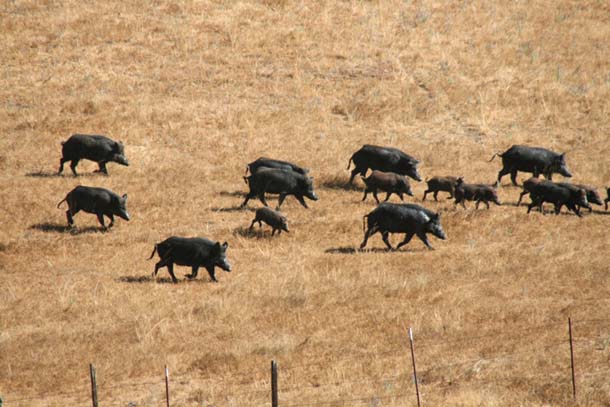
- It’s been suggested that pigs’ rooting might have an impact similar to that of the now-extinct California grizzlies. However, unlike the generally solitary bears, pigs travel in large groups called sounders. Photo by Sue Dekalb.
But the bulk of a wild pig’s diet is plant matter, along with any grubs and worms it consumes in the process of plowing its snout through the soil. And the staple food of a California wild pig’s diet is acorns. Dirk Van Vuren, a professor at UC Davis, has studied feral pigs for the last 20 years. One of his recent papers is about the link between pigs’ rooting and the regeneration of oak woodlands. “It’s like a one-two punch,” he says. “The pigs eat all of the acorns, and they uproot seedlings.” It’s not that pigs are solely responsible for the declining numbers of California’s oak trees, but they certainly factor into the equation. “Feral pigs,” says Van Vuren, “reduce oak seedling survival.”
As pigs forage for plants and acorns, they cause a cascade of ecological disturbance. First, there’s the direct consumption of native plants, bulbs, and seeds. “The biggest concern,” says Bell, “is that you’re looking at an introduced animal that is a heavy-duty predator on native plant species.” But pigs also create open areas ripe for invasive weeds. “They have a pretty drastic impact on slopes and habitats,” Bell adds.
Because of the pigs’ adaptability and the lack of large natural predators, pig populations have increased tremendously in the large swaths of protected public lands that provide the food and cover they need. So to minimize the damage, at least some of the pigs have to be removed–trapped and killed. This is where Rural Pig Management comes in.
The first few traps we check are empty. The ground around them is still covered with rancid-smelling pig bait–whole yellow corn kernels fermented in old milk, or anything potentially foul-smelling that happens to be on hand.
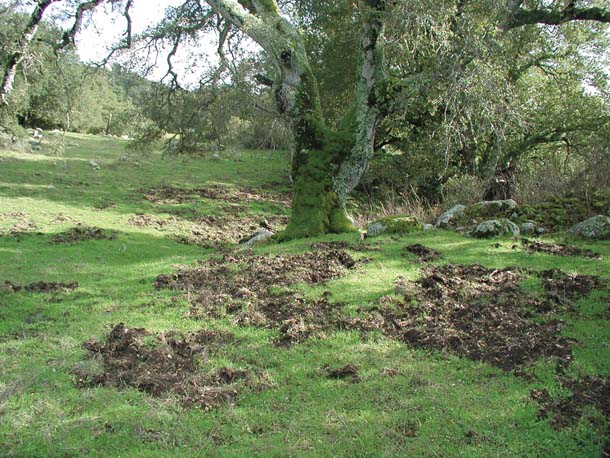
- The soil around this oak in Garin Regional Park has been rototilled by wild pigs foraging for seeds, seedlings, bulbs, and grubs. Photo by Joseph DiDonato.
In between traps we look at pig damage. It’s late spring, so the ground is dry and hard, which makes the telltale pig rooting signs a little more difficult to see than in wetter months. But after a quick lesson in reading the landscape–look for drainages or depressions first, that’s where the water is–I can see that despite the empty traps, there are pigs nearby.
Soon, it’s past dawn and we’ve ascended into the fog that still shrouds the high parts of the hills. For the last few hours we’ve been riding with a rifle between us on the bench seat of the pickup, just in case we spot a roving boar. But we pass another handful of traps, all empty. It’s starting to feel like a chartered fishing trip, with the captain constantly talking about the bounty of the waters, but without a fish in sight.
The pigs we are looking for are actually a hybrid of domestic pigs gone feral mixed with European wild boars introduced as a game species (wild boars are a separate type of pig, not to be confused with the generic “boar” for any kind of male pig). The exact origin of the Bay Area’s wild pigs is like an exurban legend. The tale starts with escapes of domestic pigs from the first Spanish missions. By the 1920s, wild pigs were released for hunting in Monterey County. Some of the original stock might have even been escaped boars from William Randolph Hearst’s giant Central Coast hunting reserve, or Russian settlers’ pigs that got loose from a railcar during a train accident.
The trapper I’m with says he catches a wider variety of pigs now than when he first started. He used to find pockets of brown or white pigs from the domestic lineage, or pockets of black pigs from the European strain, but now they are all mixed together–they vary from all black and all brown to blond, rusty, spotted, and molted.
“Pigs are the ultimate omnivores, but turkeys are right behind them,” says Bell. Pigs and turkeys are both introduced game species on the California landscape and are both thriving on protected public lands. “Pigs and turkeys are similar,” says Bell, “because they are both great cultural followers.” They thrive on the margins of our cities and towns, in the patchy open lands typical of the hills in the East Bay and elsewhere in the region.
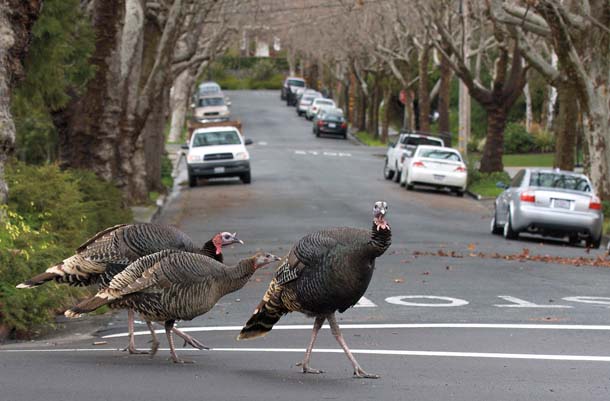
- Turkeys have become a common sight in some parts of the Bay Area, including this suburban neighborhood. While pigs are trapped and killed in many open space parks in the Bay Area, there are no organized turkey control programs. Photo by Trish Carney.
The wild turkey’s arrival here was not nearly as colorful as the train-wreck, tycoon-fueled feral pig invasion. But it was much more deliberate: The turkeys arrived due to a long effort by the California Department of Fish and Game (DFG) to establish the species as a game animal here. Starting in the 1870s and then again episodically in the early 1900s, the state released turkeys, but the efforts failed, mainly because the farm-raised birds couldn’t adapt to the wild. Then in the late 1970s DFG officials started capturing Rio Grande wild turkeys in Texas and releasing them in California, where they’ve adapted so well that their numbers have grown exponentially.
“Turkeys are everywhere now,” says Bell. By some accounts, these turkeys’ success might be explained by the fact that California once had its own species of wild turkey, or at least a turkey-like bird, that disappeared some 10,000 years ago. There’s little agreement on whether that justifies DFG’s later introductions, but researchers and officials do agree that the population across the state has ballooned in recent years to the point of becoming another ecological stressor. If pigs are like rototillers, then turkeys are like rakes. The immediate consequences of the turkey boom are not as obvious as the insatiable rooting of feral pigs, but turkeys do prey on a number of endangered plants, animals, and even other birds.
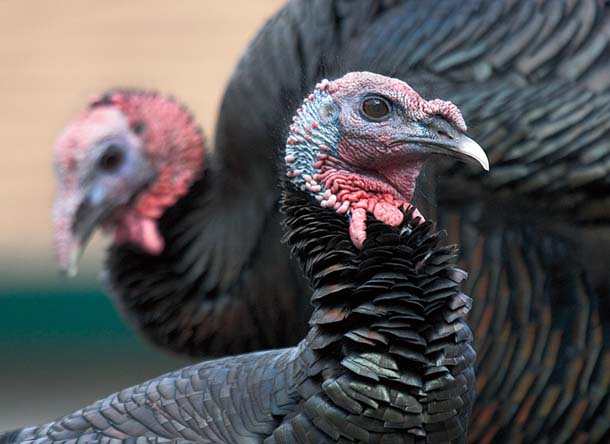
- Wild turkeys. Photo by Trish Carney.
A few years ago, Dan Gluesenkamp, the director of conservation and habitat protection at Audubon Canyon Ranch in West Marin, devised an experiment to demonstrate the impacts of turkeys on the California landscape. He built several enclosures, some that turkeys could enter, and others they couldn’t. In plots with turkeys, soil disturbance was ten times that of the exclusion plots. “The most interesting difference,” he says, “is what happened to the [soil] invertebrates. There was a substantial change in trophic structure.” The turkeys ate most of the prey bugs like the bristletails and springtails but left the predators, like spiders. They also quadrupled the rate of acorn disappearance.
Turkeys “are definitely oak woodland users,” says Joseph DiDonato, an independent Bay Area wildlife biologist. The turkeys not only join pigs as another stress on the acorn crop, but they also out-compete ground-nesting and grassland birds in their ecological niche.
So far, there’s no statewide management effort to control this species that was so painstakingly introduced, but the idea is on the radar of most public land managers. At the moment, turkeys are controlled only if there is a direct threat to people or property. “The toms can be a little aggressive during breeding season,” says Rick Parmer, the East Bay Regional Park District’s chief of interpretive amd recreation services. “If they see their reflection in a car, they can do considerable damage to someone’s paint job.” The district also sometimes gets complaints about the abundance of foraging litter and scat left in the wake of a gang of feeding turkeys.
The ecological impact of disturbances like that is complex. Feral pig rooting creates disturbance that leaves openings for both native and nonnative plants. In areas already full of exotic weeds, like many parts of the Bay Area, that’s bad news for natives, especially plants that grow from bulbs. Some biologists even consider pigs the top threat to rare native lilies. But in areas with few invasives, the pig disturbance could actually enhance habitat for certain native plants. DFG biologist Marc Kenyon says that in some places, after pig rooting, “we’ve noted more rare plants coming back.”
There’s a theory that pigs, and to a much lesser degree turkeys, create a disturbance similar to what the rooting native grizzlies or herds of sharp-hoofed tule elk once did. “There’s a certain validity to pigs providing some similar ecological services that grizzly bears used to,” says DiDonato, “but there’s also a lot of questions hanging, like are there things that pigs do that grizzlies didn’t do?”
One key difference is that bears are solitary. “Bears dig,” says Parmer, “but they dig in one spot. Pigs are gregarious, herd animals, and pigs go through entire hillsides.”
It’s the time of day now when the freeways are filling with morning commuters, but here on the trap line a day’s work is nearly over. So far, all the traps have been empty, making for a less-than-dramatic proof of concept. But there are three more traps to check. We’re riding now along a fence line, the border between a private ranch and the public park. If we had come in the winter, the trapper assures me, the difference between the public pig-controlled landscape and the private uncontrolled landscape would be immediately obvious–like night and day.
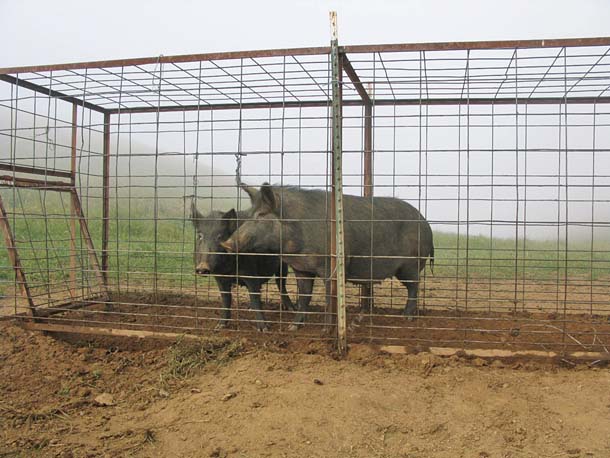
- Lured by corn soaked in sour milk, these pigs find themselves locked into a large trap. Because they’ll quickly start digging themselves out, a trapper must check the traps frequently and dispatch any captured pigs. Photo by Daniel McGlynn.
We pull up to trap number ten, planted next to a fire road in the saddle of a ridge, a perfect pig crossing. Because of the fog we are nearly on top of the trap before we make out the silhouettes of three large animals, two inside the cage and one just outside it. That last pig bolts away from us, out along the ridge and into obscurity. Swiftly, the trapper pulls his rifle from the truck and shoots at the fleeing pig. He then disappears into the fog after it. Seconds later there’s another shot. It turns out to be a 200-pound male, probably a roving boar, apparently attracted by the two sows caught in the trap.
Captured pigs are shot at close range, and the heavy carcasses are loaded in the back of the pickup with a winch and a folding ramp.
The remaining traps each have pigs in them. Trap 11 contains another large sow with a group of juveniles that weigh 50 to 60 pounds each; by the time we get to them, they’ve almost dug an escape route under the trap’s metal frame. In the last trap is a boar that weighs about 250 pounds.
These pigs are far from being just a local problem: 44 states have documented feral pig populations, up from only 17 two decades ago. Here in the Bay Area, wildlife managers at local agencies began contracting with Rural Pig Management to trap pigs on local public land in the mid-1990s. They removed 2,000 pigs in the first year. Now they average about 200 a year in the East Bay.
Feral pigs like the solitude and space of sprawling oak woodlands, so in the East Bay, they’re found all along the shoulders of Mount Diablo and down through Morgan Territory Preserve and Sunol Wilderness, as well as on the watersheds maintained by the Contra Costa Water District and East Bay Municipal Utility District (EBMUD).
Watershed managers are particularly worried about erosion and increased sedimentation caused by pigs, not to mention the potential for disease transmission. “We’re out there monitoring all the time,” says EBMUD’s Scott Hill. “We’d like to see all of the pigs removed.”
That’s not likely. “Complete eradication of feral animals is very difficult, and we seem to have an inexhaustible population of pigs from surrounding areas,” says Doug Bell. So, for now, the only viable option is control, and the only viable means of control is trapping and killing.
By the end of the morning there are ten pig corpses in the back of the trapper’s truck. He calls it “the day’s harvest.” Before leaving the park, he pulls a canvas tarp over the truck’s bed, hiding the bloody remains underneath.
What happens to those pigs? In the early days, the meat from trapped pigs was donated to local soup kitchens. “Because of federal health regulations, that’s no longer the case,” says Rick Parmer. Instead these pigs are rendered by the San Jose Tallow Company. The drop-off gets handled today, because tomorrow there will be more traps to check.

.jpg)

